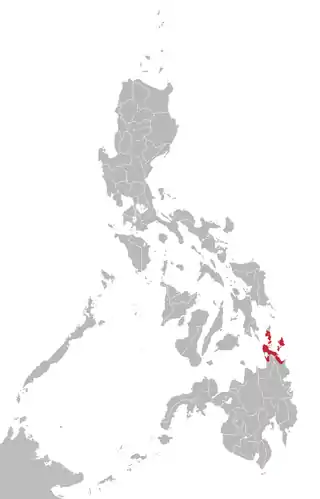Surigaonon language
Surigaonon is an Austronesian language spoken by Surigaonon people. As a regional Philippine language, it is spoken in the province of Surigao del Norte, Dinagat Islands, Surigao del Sur, and some portions of Agusan del Norte, especially the towns near Lake Mainit, Agusan del Sur and Davao Oriental.
| Surigaonon | |
|---|---|
| Tandaganon, Surigao | |
| Native to | Philippines |
| Region | Surigao del Norte, most parts of Surigao del Sur, and some portion of Dinagat Islands, Agusan del Norte, Agusan del Sur and Davao Oriental |
| Ethnicity | Surigaonon |
Native speakers | 500,000 (2009 )[1] |
Austronesian
| |
| Official status | |
Official language in | Regional language in the Philippines |
| Regulated by | Komisyon sa Wikang Filipino |
| Language codes | |
| ISO 639-3 | Either:sgd – Surigaonontgn – Tandaganon |
| Glottolog | suri1274 |
 Area where Surigaonon is spoken according to Ethnologue | |
External relationships
Surigaonon refers to the people and the language of the people of Surigao del Sur and del Norte. It is composed of ethnic languages of Surigao the mix version of Surigao's ethnic language and Cebuano.[2][3] It has been heavily influenced by Cebuano due to the influx of many Cebuanos in the region. However, most Cebuano speakers can hardly understand Surigaonon speakers, except for Cebuanos who have been living in the region for years.
Surigaonon is very closely related to the Tausug language of Sulu and the Butuanon language of Butuan.
Varieties
Tandaganon
Tandaganon[4] (also called Tinandag, Naturalis, Tagon-on) is a closely related variety spoken in Tandag and central Surigao del Sur municipalities of San Miguel, Tago, Bayabas, Cagwait, Marihatag, San Agustin, and most of Lianga. It can be classified as a separate language or alternatively as a southern variety of Surigaonon. There are about 100,000 speakers.
Surigaonon (also called Jaun-Jaun, Waya-Waya) itself on the other hand is the northern (Surigao del Norte) variety, with about 400,000 speakers. Surigaonon speakers are distributed throughout Surigao del Norte, northern Surigao del Sur, and northern Agusan del Norte.[5] Surigaonon and Tandaganon speakers can understand each other well, even if they use their own languages in conversation (similar to the mutual intelligibility between the Boholano dialect and the general Cebuano dialect).
Together, Surigaonon and Tandaganon are spoken in Surigao del Norte and most parts of Surigao del Sur, except in the City of Bislig, municipalities of Barobo, Hinatuan, Lingig, and Tagbina. In the non-Surigaonon-speaking areas of Surigao, most of the inhabitants are descended from Cebuano-speaking migrants, and the rest are natives who speak Kamayo, a Mansakan language.
Phonology
According to Dumanig (2015),[6] Surigaonon has a similar phonological inventory as its sister Bisayan languages, Cebuano and Boholano.
Vowels
Below is the vowel system of Surigaonon.
| Front | Central | Back | |
|---|---|---|---|
| Close | i | u | |
| Open | a |
Consonants
Below is a chart of Surigaonon consonants.
| Bilabial | Dental | Palatal | Velar | Glottal | ||
|---|---|---|---|---|---|---|
| Nasal | m | n | ŋ | |||
| Plosive | Voiceless | p | t | k | ʔ | |
| Voiced | b | d | ɡ | |||
| Affricate | d͡ʒ | |||||
| Fricative | s | h | ||||
| Flap | ɾ | |||||
| Lateral | l | |||||
| Approximant | w | j | ||||
Note: [j] is spelled y, [d͡ʒ] is spelled j and [ŋ] is spelled ng.
Clusters
Surigaonon has 25 consonant clusters (br, bl, bw, by, dr, dy, dw, gr, gw, kr, kl, kw, mw, my, nw, pr, pl, pw, py, sw, sy, tr, tw, ty, hw) and 4 diphthongs (aw, ay, iw, uy), which is similar to Cebuano.[6]
References
- Surigaonon at Ethnologue (18th ed., 2015) (subscription required)
Tandaganon at Ethnologue (18th ed., 2015) (subscription required) - Lobel (2013).
- Zorc (1977).
- ISO 639-3 Registration Authority (2009). "Request for New Language Code Element in ISO 639-3" (PDF). request number 2009-087.
- "Surigaonon". Ethnologue.
- Dumanig, Francisco Perlas (2015). "Descriptive Analysis of the Surigaonon Language". Polyglossia. 27: 1–10. doi:10.34382/00011430. hdl:10367/6111.
Further reading
- Lobel, Jason William (2013). Philippine and North Bornean Languages: Issues in Description, Subgrouping, and Reconstruction (PDF) (PhD thesis). University of Hawaiʻi at Mānoa.
- Rubrico, J. G. (1999). Magbinisaya Kita: Cebuano Primer I. Quezon City: IJR Links and Consultant.
- Zorc, David Paul R. (1977). The Bisayan Dialects of the Philippines: Subgrouping and Reconstruction (PDF). Pacific Linguistics Series C - No. 44. Canberra: The Australian National University. ISBN 0-85883-157-0.